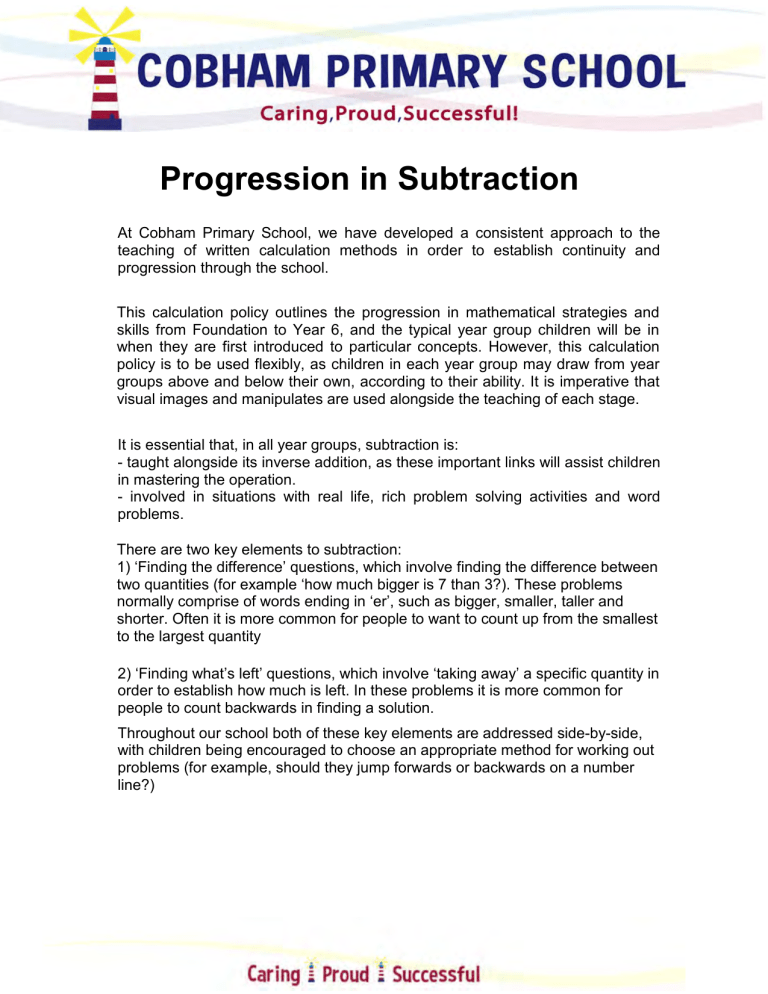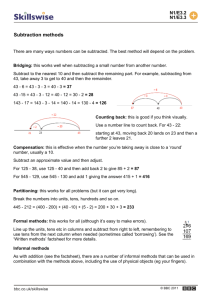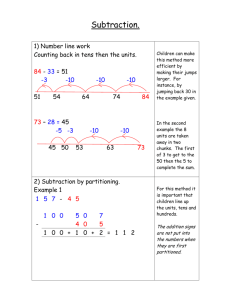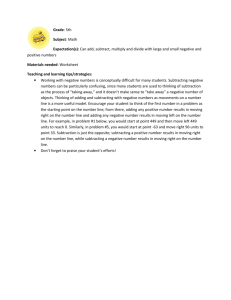Subtraction Progression

Progression in Subtraction
At Cobham Primary School, we have developed a consistent approach to the teaching of written calculation methods in order to establish continuity and progression through the school.
This calculation policy outlines the progression in mathematical strategies and skills from Foundation to Year 6, and the typical year group children will be in when they are first introduced to particular concepts. However, this calculation policy is to be used flexibly, as children in each year group may draw from year groups above and below their own, according to their ability. It is imperative that visual images and manipulates are used alongside the teaching of each stage.
It is essential that, in all year groups, subtraction is:
- taught alongside its inverse addition, as these important links will assist children in mastering the operation.
- involved in situations with real life, rich problem solving activities and word problems.
There are two key elements to subtraction:
1) ‘Finding the difference’ questions, which involve finding the difference between two quantities (for example ‘how much bigger is 7 than 3?). These problems normally comprise of words ending in ‘er’, such as bigger, smaller, taller and shorter. Often it is more common for people to want to count up from the smallest to the largest quantity
2) ‘Finding what’s left’ questions, which involve ‘taking away’ a specific quantity in order to establish how much is left. In these problems it is more common for people to count backwards in finding a solution.
Throughout our school both of these key elements are addressed side-by-side, with children being encouraged to choose an appropriate method for working out problems (for example, should they jump forwards or backwards on a number line?)
Strategy
Using songs and number rhymes
Example
‘Five little speckled frogs’
‘Five little men in a flying saucer’
‘10 Green Bottles’
Subtraction vocabulary will be introduced.
This includes ‘take away’, ‘less than’ and ‘subtract’.
Children will be initially taught that, when subtracting, the answer is smaller than the starting number.
They will count and point using objects, and subtract them by physically moving each item. Whenever possible we use real life experiences to develop the children’s understanding of subtraction.
Rationale
Children will use their counting skills to find ‘one less’ than a quantity, using their fingers to help them to count
(from 10).
Children will also use objects, pictures, stories and songs to help develop their understanding.
Subtraction using pictures
Example
I have 5 balloons.
2 burst.
How many do I have left?
Example
-
3 - 2 = 1
Example
4 – 1 = 3
-
The formal method of recording will be introduced.
The children will continue to develop their understanding of the vocabulary associated with subtraction.
Using a picture helps children to visualise the problem (for example they could cross out each item as it is
‘taken away’).
The children will respond to questions like ‘How many are left?’
Subtraction using a number line
Children will develop their ability to subtract (by ‘taking away’). This will involve them jumping backwards on a number line. This will prepare them to deal with larger quantities, and it will also become more time efficient.
Children start using a number line to subtract only units at a time (not tens).
Example
What is 11 take away 7?
11 – 7 =
0 1 2 3 4 5 6 7 8 9 10 11 12 13 14 15 16 17 18 19 20
Start on 11, and ‘jump back’ 7 spaces.
11 – 7 = 4
Children will be shown to mark their jumps under the number line to show that it is the opposite to add and therefore make links to the inverse.
Subtraction by finding the difference
After having experienced subtraction as ‘taking away’, the children will be introduced to subtraction as ‘finding the difference’.
Example
Which plate holds the most: black or white?
How many more? What is the difference?
The use of double sided counters could also help children to understand this concept.
What is the difference between 8 and 3?
Finding the difference is introduced pictorially. The first example shows how this type of problem is solved by counting the objects to find how many more are needed.
Children can also solve subtraction problems by counting on or counting back using a number line.
The method that the children will use will depend upon how they ‘see’ a problem.
Example
What is the difference between 11 and 4?
0 1 2 3 4 5 6 7 8 9 10 11 12 13 14 15 16 17 18 19 20
Children will start on either number, or ‘jump’ until they reach the other (this is possible in either direction, but is normally thought of as ‘jumping on’).
If a child is stuck on the problem they will be encouraged to count on from the smallest number (as this is normally the case when, for example, finding the difference between the heights of 2 people).
Introducing a hundred square
Children will use a hundred square to ‘jump back’ particular amounts.
Example
7 count back 2 = 5
7 – 2 = 5
They will then move to a more efficient method of subtracting
10 to a number (jumping vertically rather than horizontally).
Example
48 count back 10 = 38
Children begin to use
100 squares as a tool to aid counting back in small steps (eg. in
1s or 2s)
Once secure they begin to use the 100 square to count back in tens.
Children learn that as they move down a row they subtract 10 each time.
Careful attention is given to possible misconceptions at this stage, especially jumping on their starting number, instead of always moving horizontally with each move.
48 – 10 = 38
Introducing partitioning (2 digit numbers)
Children will learn that numbers 10 or over (and under 100) are made up of TENS
(left hand digit) and UNITS (right hand digit).
Partitioning a number involves splitting it up into TENS/UNITS to show the value of each digit.
Initially this will be practically done using bundles of sticks before moving to
‘Base 10’ which become more abstract in the representation of 10.
Example 34 is made from:
This method is also used when children are introduced to the idea of adding
HUNDREDS.
3 (tens) 4 (units)
As children become secure they will say the value of each digit without apparatus.
More complex subtraction using a hundred square
Prior to using the hundred squares below the children will need to have a secure understanding of t he value of each digit in a number, as determined by its position ( place value).
Using a hundred square
Example
58 – 12 =
Children learn to use hundred squares to subtract 2 digit numbers.
The children will be able to use a hundred square to ‘find the difference’ and to
‘take away’ as they gain in confidence with using it. 58 – 12 = 46
Subtracting 12 involves moving up a row, and then to the left 2 places.
Subtraction using place value
An amount can be subtracted by first partitioning the starting number into ‘tens’ and
‘units, and then removing a number of these according to the amount to subtract.
Example
47 – 12 =
47 comprises of:
1 ten and 2 units are ‘taken away’
(since we are subtracting ‘12’)
Children will be taught to subtract large numbers using partitioning. This can be done using manipulative such as
‘Base 10’
(representing the
‘tens’ and representing the
‘ones/units’
4 tens 7 units
23 – 12 =
Children will need lots of practical experience and discussion to understand this process.
leaving 3 tens and 5 units (35).
so 47 – 12 =35
Subtraction using a number line
At this stage the children will learn how to subtract a two-digit number by subtracting the ‘tens’ and ‘units’ within this number using two number line jumps (rather than just jumping back in units).
Example
47 – 12 =
Using number lines it is easier to take larger jumps (eg. in 10s).
When using a number line, children will display their jumps above the line, and numerals underneath to aid presentation.
35 36 37 38 39 40 41 42 43 44 45 46 47
In this example, one ‘ten’ is subtracted, followed by two ‘units’.
It is important for children here to appreciate that number lines go on infinitely, including into negative numbers.
Noticing shortcuts on number lines
Children will develop their ability to use a number line, including shorter methods to help them when appropriate.
Example
22 – 7 =
The use of bead strings will support them in bridging to the next multiple of 10.
13 14 15 16 17 18 19 20 21 22 23
In this example, the children will recognise that they are able to jump to the next multiple of ten (subtracting 2), before subtracting the remainder (5).
Example
16 – 9 =
6 7 8 9 10 11 12 13 14 15 16 17
In this example, the children will recognise that ‘9’ is nearly the same as subtracting 10. They will therefore subtract 10, before adjusting their answer to suit the question.
Counting on using a blank number line to
The children will use a blank number line to count on larger amounts, much like the strategies above. They will record significant numbers along the number line, and think carefully about how best to utilise their understanding of multiples of ten to help them when calculating.
23
find the difference
Example
What is the difference between 23 and 60?
+ 30 so the difference is 37.
57
7
60
It is important for the children to display the number of ‘jumps’ they have made above the number line, so that these can easily be translated into a number sentence afterwards.
This blank number line strategy will be used to underpin the relationships between addition and subtraction.
(Subtracting the tens)
(Subtracting the units)
Towards a formal method without ‘exchanging’
Example
87 – 32 = ?
80 – 30 = 50
7 – 2 = 5
50 + 5 = 55
Children will begin to move towards informal written methods. They use partitioning with no exchanging taking place between the
‘tens’ and ‘units’ numbers.
Formal written methods (1)
The children will subtract a two-digit number from another using a formal written method, which does not involve exchanging. The children will start with the ones/unit digits. The placing of the operation on the right hand side will reinforce this.
Example
38 – 13 = ?
38
13 -
_ 25 so 38 – 13 = 25
Children are introduced to column subtraction without any exchange.
Initial understanding of place value and the method will be reinforced with ‘Base
10’. Start with the biggest number and take away the smaller.
Formal written methods (2)
Once children have mastered the subtraction strategy involving two digit numbers without exchanging, children will develop the ability to exchange when necessary.
Here they will draw upon their knowledge of partition into Tens and Ones/Units alongside their knowledge of partitioning in different ways.
Example
38 – 19 = ?
2 1
3 8
- 1 9
1 9
This process of exchanging will be refered to as ‘taking and giving’ not ‘borrowing’.
Exchanging involves a ‘ten’ being exchanged for ten
‘units’ in order for a problem to be calculated correctly.
‘Base 10’ should be used to make the process of exchanging explicit.
The term ‘borrowing’ must not be used , as the units are never exchanged back to a ten.
This process is then repeated for three-digit numbers, with the children experiencing first the calculation without a need to ‘exchange’ and then involving ‘exchanging’.
Example
243 – 122 = ?
243
- 122
_ 121
Formal written methods (3/4)
Example
443 – 237 = ?
4 4 3
- 2 3 7
2 0 6
Example
400 – 199 = ?
9
4 0 0
- 1 9 9
2 0 1
Exchanging involves a higher digit being exchanged, for example a ‘ten’ being exchanged for ten
‘units’, or a ‘hundred’ being exchanged for ten ‘tens’. This then enables a problem to be calculated correctly. so 243 – 122 = 121
While teaching this method it is vital to reinforce the importance of choosing the most efficient method to subtract, e.g. 300 – 12 would be quicker to solve mentally; subtracting 10 and then 2.
The term ‘borrowing’ must not be used as, for example, the units are never exchanged back to a ten.
Decimal numbers
The children will also be given opportunities to subtract numbers with a different number of decimal places
(eg. 34.85 –
14.7). Putting a 0 in any ‘spare’ spaces will help then to put the digits in the correct place.




